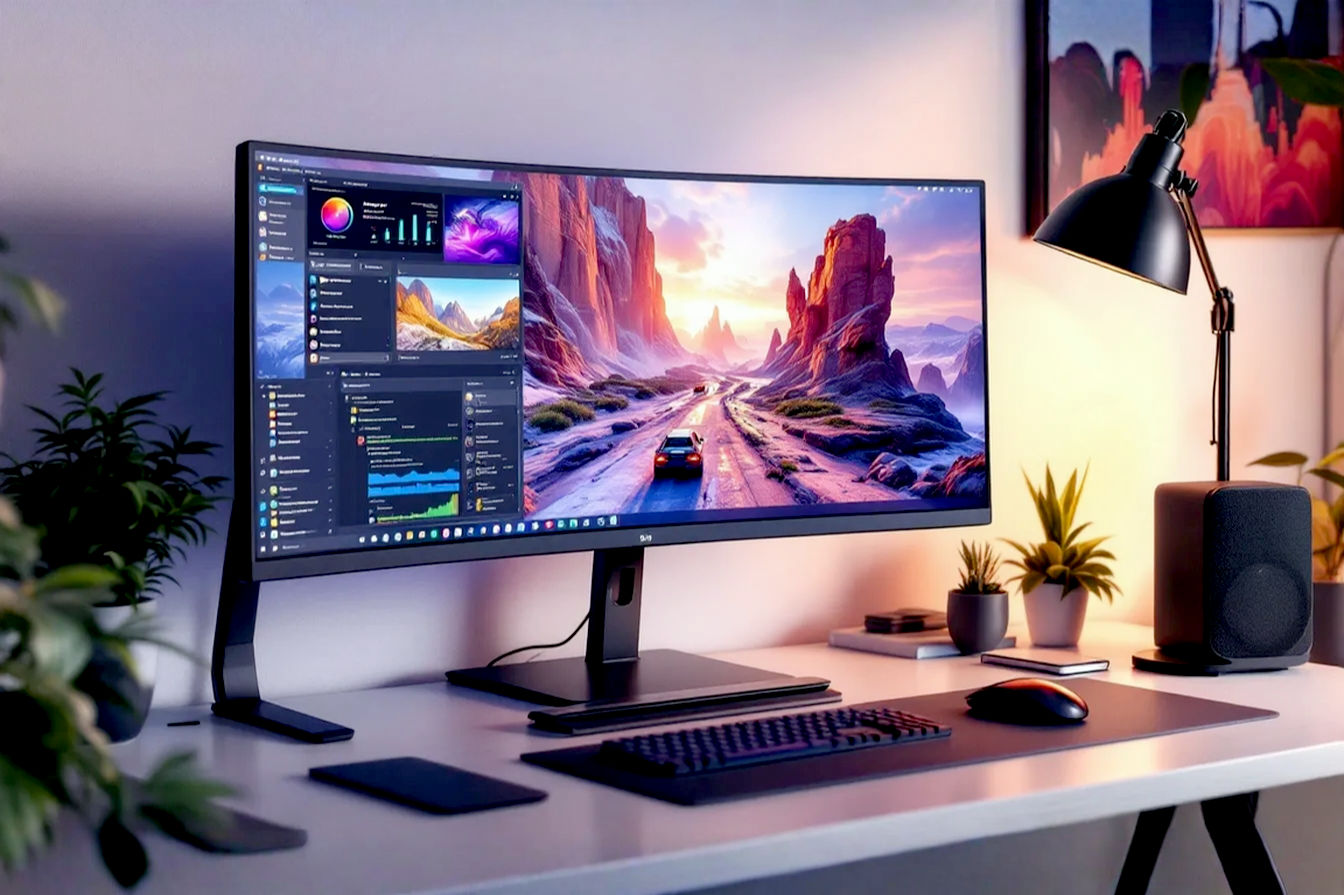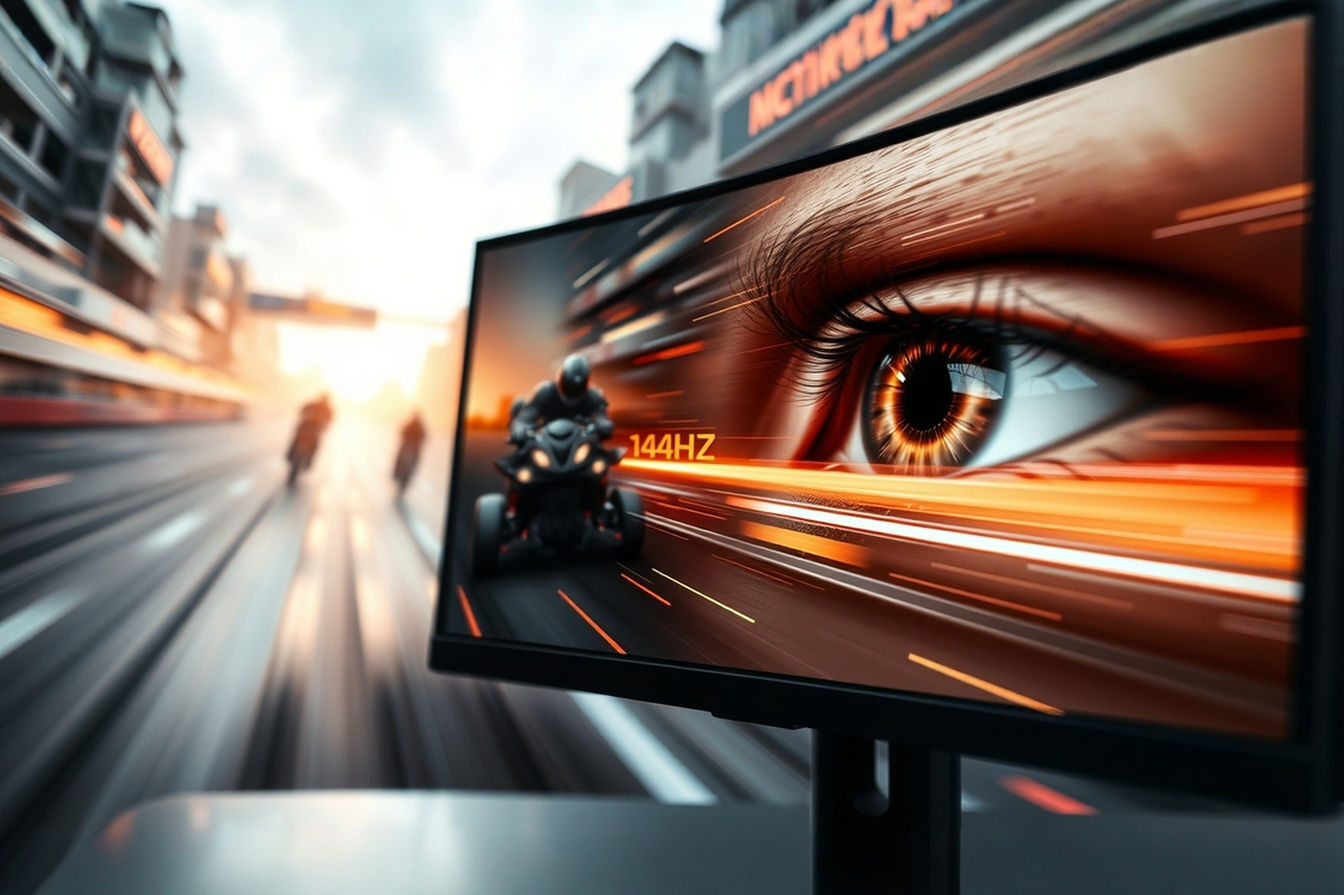This post may contain affiliate links. If you make a purchase through these links, we may earn a commission at no additional cost to you.
Connecting a monitor to your computer used to mean dealing with a tangle of different cables. Remember VGA, DVI, or the early days of HDMI and DisplayPort? Each had its own plug shape and capabilities. While HDMI and DisplayPort simplified things by carrying both video and audio, you still needed separate cables for power, data from USB devices, or even network access if you were using a docking station. It could get pretty messy behind your desk.
But things are changing. A newer, more versatile connector has arrived: USB-C. You’ve probably seen it on newer laptops, phones, and tablets. It’s small, reversible (so there’s no “wrong” way to plug it in!), and designed to do a lot more than just transfer files or charge your phone. When it comes to monitors, USB-C, specifically when it includes something called DisplayPort Alternate Mode, is quickly becoming the must-have connection. It’s not just a minor upgrade; it’s a fundamental shift that can make your workspace cleaner, more flexible, and more powerful.
This article will dive into why a monitor with a USB-C port supporting DisplayPort is such a big deal. We’ll break down what this technology is, how it works its magic, and why you should absolutely look for it the next time you’re buying a new display.
Understanding USB-C: More Than Just a Port
Before we talk about video, let’s get a better handle on USB-C itself. Physically, it’s that sleek, oval-shaped connector you see on many modern gadgets. Its reversible design was a huge win for convenience – no more fumbling to plug in a cable in the dark!
But the real power of USB-C isn’t just its shape; it’s the technology packed inside. Unlike older USB ports that primarily handled data, or dedicated ports like HDMI that only did audio/video, USB-C was designed from the ground up to be a true do-it-all connector. It can handle high-speed data transfer, deliver significant amounts of power (enough to charge a laptop!), and, crucially for our topic, carry other types of signals using something called “Alternate Modes.”
Think of the USB-C port as a multi-lane highway. Depending on what’s connected and what capabilities the devices support, those lanes can be used for different kinds of traffic – data, power, or even video. This is a big departure from older ports, which were more like single-purpose roads. However, and this is a critical point that sometimes causes confusion, not every USB-C port supports every single one of these functions. A USB-C port might only be wired for data and basic charging, while another identical-looking port on a different device could handle data, fast charging, and video output.
The Key Technology: DisplayPort Alternate Mode (Alt Mode)
The ability for a USB-C port to send video signals comes thanks to those “Alternate Modes” we just mentioned. An Alternate Mode, or “Alt Mode” for short, is a function that allows the USB-C connection to temporarily dedicate some or all of its high-speed data lanes to a different standard or protocol. Instead of just sending USB data, it can switch gears and send something else entirely.
One of the most important and widely adopted Alt Modes is DisplayPort Alternate Mode. As the name suggests, this Alt Mode lets a USB-C port transmit a native DisplayPort audio/video signal. This means the DisplayPort data, which is normally sent over a standard DisplayPort cable, can now travel over a USB-C cable using the pins within the USB-C connector.
Why DisplayPort? DisplayPort is a video standard developed by the Video Electronics Standards Association (VESA). It’s known for its high performance, support for multiple monitors from a single output (Multi-Stream Transport, or MST), and its use of packetized data transmission. This packetized approach, similar to how data is sent over networks, makes it very flexible and well-suited to sharing the USB-C connection with other data types. Because DisplayPort is already a robust and widely used standard in the computer world, enabling it over USB-C via Alt Mode was a natural fit.
When a device (like a laptop) and a monitor are connected with a USB-C cable and both support DisplayPort Alt Mode, they communicate over the connection’s dedicated configuration pins. They figure out what capabilities they share and agree to enter DisplayPort Alt Mode. Once that handshake is complete, the USB-C port on the laptop starts sending DisplayPort video signals, and the USB-C port on the monitor is ready to receive them and display the image.
How DisplayPort Alt Mode Works: A Technical Deep Dive
Understanding how DisplayPort Alt Mode works technically helps explain its capabilities and limitations. Inside a standard USB-C connector and cable, there are multiple high-speed data pathways, often referred to as “lanes.” For USB 3.x speeds (like SuperSpeed 5Gbps or SuperSpeed+ 10Gbps), there are typically four such lanes, used in pairs for sending and receiving data simultaneously. There are also pins for older USB 2.0 data, power, ground, and the crucial Configuration Channel (CC) pins.
DisplayPort Alt Mode works by repurposing some or all of these high-speed data lanes to carry DisplayPort signals instead of USB data. This process is called multiplexing. The electronics in the devices on both ends of the cable handle this switching and routing of signals.
Here’s a breakdown of the common lane configurations when DisplayPort Alt Mode is active:
- 2 Lanes for DisplayPort, 2 Lanes for USB 3.x Data: This is a very common configuration. Two of the high-speed lanes are dedicated to sending DisplayPort video from the source device to the monitor. The other two high-speed lanes remain available for USB 3.x data transfer, allowing the monitor’s built-in USB hub to operate at SuperSpeed (5Gbps) or SuperSpeed+ (10Gbps) speeds. In this setup, USB 2.0 data is also available over separate pins, often used for peripherals like keyboards and mice even when the high-speed lanes are busy.
- 4 Lanes for DisplayPort, USB 2.0 Data Only: In this configuration, all four high-speed lanes are dedicated to sending DisplayPort video. This maximizes the bandwidth available for the display signal, which is great for very high resolutions or refresh rates. However, because the high-speed lanes are fully occupied by video, the monitor’s USB hub functionality is limited to the slower USB 2.0 speeds (480 Mbps). The USB 2.0 pins are separate from the high-speed lanes and aren’t affected by the Alt Mode configuration.
The specific configuration used is negotiated between the source device and the monitor when they connect. They determine the needs of the display (resolution, refresh rate) and the capabilities of both devices and the cable to decide the best way to allocate the lanes.
The Configuration Channel (CC) pins play a vital role in this. When you plug in a USB-C cable, the devices use these pins to:
- Detect that a connection has been made.
- Determine the cable’s capabilities (e.g., if it’s rated for high speeds or high power).
- Identify the orientation of the reversible plug.
- Negotiate the power delivery contract (how much power will be sent and in which direction).
- Discover and enter Alternate Modes, such as DisplayPort Alt Mode. This involves exchanging “Structured Vendor Defined Messages” (VDMs) as part of the USB Power Delivery protocol, even if no power is being delivered. This handshake confirms that both devices support DP Alt Mode and agrees on the lane configuration and DisplayPort version to use.
This technical flexibility is what makes USB-C with DisplayPort Alt Mode so powerful. It can adapt to different scenarios, prioritizing either maximum display performance or a balance between video and high-speed data, all over a single cable.
Bandwidth Capabilities: Powering High-Resolution Displays
Bandwidth is a crucial concept when talking about display connections. It refers to the amount of data that can be transmitted through the cable per second. More bandwidth means the connection can handle higher resolutions, faster refresh rates, greater color depth, and advanced features like High Dynamic Range (HDR) simultaneously.
DisplayPort Alt Mode leverages the inherent high bandwidth of the USB-C connector’s high-speed lanes to carry DisplayPort signals. The maximum video bandwidth available depends on two main factors: the version of the DisplayPort standard being used via Alt Mode and the lane configuration (2 lanes or 4 lanes for DisplayPort).
Here’s a look at the typical effective video bandwidths for different DisplayPort versions when used over USB-C Alt Mode:
- DisplayPort 1.2 Alt Mode: This version offers up to 17.28 Gigabits per second (Gbps) of effective video bandwidth. This is enough to drive a single 4K (3840×2160) monitor at 60Hz with standard 8-bit color depth. It can also handle lower resolutions at higher refresh rates or multiple displays via daisy-chaining, but the total bandwidth limit applies.
- DisplayPort 1.4 Alt Mode: A significant step up, DP 1.4 increases the effective bandwidth to 25.92 Gbps. This version also introduced support for Display Stream Compression (DSC). DSC is a visually lossless compression technique standardized by VESA. It allows the DisplayPort signal to carry much higher resolutions and refresh rates than the raw bandwidth would normally allow by compressing the video data before sending it over the cable and decompressing it at the monitor. With DP 1.4 Alt Mode (especially when using 4 lanes for video) and DSC, you can achieve configurations like 4K at 120Hz or even 8K resolution, often with HDR and higher color depths.
- DisplayPort 2.0 / 2.1 Alt Mode: These are the latest and most powerful versions. They dramatically increase the total available bandwidth to a maximum payload of 77.37 Gbps. This is achieved using new, higher-speed signaling rates per lane, known as UHBR (Ultra High Bit Rate) 10 (10 Gbps/lane), UHBR 13.5 (13.5 Gbps/lane), and UHBR 20 (20 Gbps/lane). With DP 2.0/2.1 Alt Mode, even when sharing the connection with USB 3.x data (using 2 lanes for video), you can still drive very high resolutions and refresh rates, such as three 4K monitors at 90Hz or even 144Hz with DSC. When using all 4 lanes for video, DP 2.0/2.1 Alt Mode can support configurations like a single 8K display at 60Hz with full color and HDR without compression, or even 10K and 16K resolutions with DSC.
The amount of bandwidth needed for a specific display setup depends on the resolution (number of pixels), refresh rate (how many times the image updates per second), color depth (how many bits are used to represent each color, affecting the total number of colors), and chroma subsampling (a compression technique that reduces color information). Higher values for any of these require more bandwidth.
For example, sending a 4K signal (3840×2160 pixels) at 60Hz with standard 8-bit RGB color requires roughly 14.85 Gbps of bandwidth. Both DP 1.2 and DP 1.4 Alt Mode can handle this, even in a 2-lane configuration that also allows USB 3.x data. However, pushing to 4K at 144Hz with 10-bit color and HDR requires significantly more bandwidth, often necessitating DP 1.4 Alt Mode with DSC or DP 2.0/2.1 Alt Mode, potentially using all 4 lanes for video.
The technical details of bandwidth and lane configuration highlight the importance of checking the specifications of both your device and the monitor, as well as the quality and rating of the USB-C cable you use. A cheap or older cable might not be certified to handle the speeds required for the highest resolutions and refresh rates, even if the devices support them.
The Compelling Advantages of USB-C DisplayPort for Monitors
Equipping a monitor with a USB-C port that supports DisplayPort Alt Mode brings a host of benefits that significantly improve the user experience, especially in today’s world of thin laptops and mobile devices.
The Single Cable Solution: Simplicity and Convenience
Perhaps the most immediately noticeable advantage is the ability to use a single cable for multiple functions. With a compatible monitor and device, one USB-C cable can transmit high-resolution video, send and receive data (for peripherals connected to the monitor), and even provide power to charge the connected laptop or device.
This eliminates the need for separate cables for video (like HDMI or DisplayPort), USB data (for a hub), and power (the laptop’s power brick). The result is a dramatically cleaner and less cluttered workspace. Connecting your laptop to your desk setup becomes incredibly simple: just plug in one cable, and you’re instantly connected to your external monitor, keyboard, mouse, webcam, and charger. This is a game-changer for people who frequently connect and disconnect their laptops, whether they’re moving between rooms, going to meetings, or switching between work and personal use.
Power Delivery (USB PD): Charging Your Device
A key part of the single-cable dream is Power Delivery (USB PD). USB PD is a specification that allows power to be sent over the USB-C cable in either direction, at much higher wattages than older USB standards. Monitors equipped with USB-C DisplayPort often integrate USB PD functionality.
This means the monitor itself can act as a charger for your connected laptop, tablet, or even smartphone. Instead of needing to plug your laptop into its power adapter and a separate video cable and a USB hub, the monitor provides the power directly through the same USB-C cable carrying the video signal.
Monitors vary in the amount of power they can deliver, commonly ranging from 65W to 90W, and sometimes even 100W or more. For many modern laptops, 65W or 90W is sufficient to charge them even while they’re in heavy use. It’s essential to check the power requirements of your specific device and ensure the monitor’s USB PD output meets or exceeds that wattage for reliable charging. This feature is incredibly convenient, reducing the number of power bricks and cables needed on your desk or to carry with you.
High Resolution and Refresh Rate Support
As we discussed in the bandwidth section, DisplayPort Alt Mode is built on the capable DisplayPort standard, meaning it can handle very demanding display requirements. New monitors with USB-C DisplayPort can easily support high resolutions like 4K (3840×2160), 5K (5120×2880), and even 8K (7680×4320).
Beyond just the pixel count, it also supports high refresh rates. This is particularly important for gamers who want smooth, blur-free motion, but it also benefits anyone who spends a lot of time looking at a screen, making scrolling and general desktop use feel much more fluid. Refresh rates of 120Hz, 144Hz, 240Hz, and beyond are possible over USB-C DisplayPort, depending on the specific DisplayPort version (1.4 with DSC or 2.0/2.1) and the capabilities of the connected device.
Furthermore, DisplayPort Alt Mode supports advanced display features like High Dynamic Range (HDR), which provides a wider range of colors and contrast for more vibrant and realistic images, and deep color depths (like 10-bit or 12-bit color) essential for professional photo and video editing.
Data Transfer Capabilities: Built-in USB Hub
When a monitor supports DisplayPort Alt Mode and has additional USB-A ports or even another downstream USB-C port, it effectively acts as a USB hub. This means you can plug your keyboard, mouse, webcam, external hard drive, or other USB peripherals directly into the monitor.
The data from these peripherals travels back to your connected laptop or device over the same single USB-C cable that’s carrying the video signal. This is where the lane configuration we discussed earlier becomes relevant. If the connection is using 2 lanes for DisplayPort and 2 lanes for USB 3.x data, the monitor’s USB hub can operate at high SuperSpeed (5Gbps) or SuperSpeed+ (10Gbps) speeds, allowing for fast file transfers to external drives. If the connection is using all 4 lanes for DisplayPort (to maximize video bandwidth), the USB hub functionality will be limited to USB 2.0 speeds (480 Mbps), which is fine for keyboards, mice, and webcams but slow for storage devices.
Regardless of the speed, having a built-in USB hub in the monitor simplifies your desk setup and reduces the need for a separate dongle or hub connected directly to your laptop, especially if your laptop has limited ports.
Monitor Daisy-Chaining (Multi-Stream Transport – MST)
DisplayPort has a feature called Multi-Stream Transport (MST) that allows a single DisplayPort output from a device to drive multiple monitors by sending independent video signals down a single cable to a compatible monitor, which then forwards (chains) the signal to the next monitor, and so on.
USB-C DisplayPort Alt Mode supports this MST feature. This means you can connect your laptop to the first monitor using a single USB-C cable, and then connect the first monitor to a second monitor (and potentially a third, depending on bandwidth) using standard DisplayPort cables between the monitors, or sometimes even another USB-C cable if the monitors have a downstream USB-C port with DP Alt Mode output.
Daisy-chaining is a fantastic way to set up a multi-monitor workspace with minimal cabling back to the source device. It keeps your desk tidy and is especially useful for laptops with only one or two video outputs. The number and resolution of monitors you can daisy-chain are limited by the total bandwidth available over the USB-C connection and the capabilities of your device’s graphics card.
Future-Proofing Your Setup
Technology moves fast, but USB-C with DisplayPort Alt Mode is positioned to be the standard for monitor connectivity for the foreseeable future. More and more laptops, tablets, and even smartphones are adopting USB-C as their primary or only port. Dedicated video ports like HDMI and standard DisplayPort are becoming less common on thin and light devices.
By choosing a monitor with USB-C DisplayPort, you’re investing in a display that will be compatible with a wide range of current and future devices. The ongoing evolution of the DisplayPort standard (with versions 2.0 and 2.1 offering massive bandwidth increases) ensures that DisplayPort Alt Mode over USB-C will be able to support even higher resolutions and refresh rates as technology progresses. Furthermore, newer standards like USB4 and Thunderbolt 4/5 utilize the USB-C connector and inherently tunnel DisplayPort signals, ensuring seamless compatibility with monitors using DisplayPort Alt Mode.
This future compatibility means your monitor will likely remain relevant and easy to connect to your devices for years to come, saving you from needing adapters or replacing your monitor prematurely.
USB-C DisplayPort vs. Traditional Connections (HDMI, DisplayPort)
It’s helpful to compare USB-C DisplayPort to the established video connections you might be more familiar with to understand where it fits in and why it’s gaining prominence.
Comparing it to HDMI (High-Definition Multimedia Interface):
HDMI is ubiquitous, found on TVs, monitors, game consoles, Blu-ray players, and more. It’s great for consumer electronics and home theater setups. Like DisplayPort, it carries both audio and video over a single cable. However, standard HDMI cables don’t carry data for a USB hub or deliver significant power to the source device. While newer HDMI versions (like HDMI 2.1) offer very high bandwidth for 4K and 8K gaming with high refresh rates, they still lack the integrated data and power capabilities of USB-C. USB-C with DisplayPort Alt Mode shines in a computer workspace environment where you want to connect multiple peripherals and charge your laptop with a single plug.
Comparing it to Standard DisplayPort:
Standard DisplayPort uses a different, larger connector (though there’s also a Mini DisplayPort). It’s very common on desktop graphics cards and many business laptops. It offers high bandwidth and supports features like MST for daisy-chaining, similar to DisplayPort Alt Mode over USB-C. The key difference is the connector itself and the additional capabilities that USB-C brings to the table. A standard DisplayPort cable only carries video and audio (plus a small auxiliary channel for data). It cannot carry high-speed USB data or deliver significant power to the source device over the same cable. USB-C DisplayPort takes the core DisplayPort video technology and integrates it into the versatile USB-C connector, adding the ability to simultaneously handle data and power, which is a major convenience factor, especially for laptops with limited ports.
It’s also worth briefly mentioning Thunderbolt. Thunderbolt (versions 3 and later) uses the USB-C connector and is often confused with standard USB-C. Thunderbolt is a technology developed by Intel that is built on top of the USB-C standard. It tunnels multiple protocols, including DisplayPort, PCI Express (for high-speed data like external GPUs or storage), and USB data, all over a single cable. Thunderbolt connections offer even higher bandwidth (up to 40Gbps for Thunderbolt 3/4, 80Gbps for Thunderbolt 5) than standard USB-C with DisplayPort Alt Mode and can support more complex setups, like multiple high-resolution displays and very fast external storage simultaneously. Devices and monitors with Thunderbolt ports are typically compatible with USB-C DisplayPort Alt Mode, but the reverse is not always true – a standard USB-C port with DP Alt Mode won’t necessarily support Thunderbolt devices at Thunderbolt speeds. Thunderbolt represents the highest tier of single-cable connectivity using the USB-C connector.
In essence, while HDMI and standard DisplayPort are excellent for their primary function of video transmission, USB-C DisplayPort offers a more integrated and convenient solution for modern computing by combining high-performance video with data and power delivery over a single, reversible connector.
What to Look for When Buying a USB-C DisplayPort Monitor
Choosing a new monitor can be confusing with all the different features and specifications. If you’ve decided that the convenience and capability of USB-C DisplayPort are right for you, here’s what you should specifically look for to ensure you get a monitor that meets your needs and works correctly with your devices:
First and foremost, verify that the USB-C port on the monitor explicitly supports DisplayPort Alternate Mode. Don’t just assume that because a monitor has a USB-C port, it can receive video over it. Some monitors might have a USB-C port only for data (to act as a simple USB hub, requiring a separate video cable) or only for upstream connection to a computer for the monitor’s own settings software. The product specifications or manual should clearly state “DisplayPort Alt Mode,” “DP Alt Mode,” or “Display over USB-C.”
Next, check which version of DisplayPort Alt Mode is supported. This is usually tied to the DisplayPort version (DP 1.2, DP 1.4, DP 2.0/2.1). Knowing this will give you an idea of the maximum resolutions and refresh rates the monitor can accept over that USB-C connection, especially if you plan on using features like HDR or high refresh rates. If the monitor supports DP 1.4 Alt Mode, look for mention of Display Stream Compression (DSC) support, as this is often necessary to achieve the highest display modes.
If you want the convenience of charging your laptop or device through the monitor, check the Power Delivery (USB PD) wattage the monitor’s USB-C port can output. This is usually listed in watts (W), e.g., 65W, 90W, 100W. Compare this number to the power adapter wattage that came with your laptop. For reliable charging, the monitor’s PD output should ideally be equal to or greater than your laptop’s power requirement. While a lower wattage might still charge your laptop, it might do so slowly or not at all under heavy load.
Consider the additional USB ports the monitor offers. If the monitor acts as a USB hub, how many USB-A ports does it have? What speed are they (USB 3.0/3.1/3.2 SuperSpeed 5Gbps or 10Gbps, or older USB 2.0 480Mbps)? This affects how fast you can transfer data to devices plugged into the monitor. Remember that if the monitor is using 4 lanes for DisplayPort video, the USB data speeds will likely be limited to USB 2.0, even if the monitor has faster USB 3.x ports.
If you plan on connecting multiple monitors in a series from a single USB-C cable (daisy-chaining), ensure the monitor supports Multi-Stream Transport (MST) over its USB-C DisplayPort connection. Most monitors with DP Alt Mode 1.2 or later will support MST, but it’s always good to confirm in the specifications.
Finally, pay attention to the type and quality of the USB-C cable included with the monitor or that you plan to use. Not all USB-C cables are created equal. For DisplayPort Alt Mode, especially at higher resolutions and refresh rates, you’ll need a cable rated for the necessary speed and capabilities. Look for cables certified for USB 3.1 Gen 2 (10Gbps) or USB 3.2 Gen 2 (10Gbps) or Gen 2×2 (20Gbps), and ideally explicitly stating support for DisplayPort Alt Mode and the appropriate Power Delivery wattage (e.g., 60W or 100W). Using an inadequate cable can lead to issues like lower refresh rates, lower resolutions, or the monitor not working at all.
Reading detailed product specifications and reviews from other users can help ensure the monitor’s USB-C port functions exactly as you expect it to.
Real-World Use Cases and Scenarios
The benefits of USB-C DisplayPort connectivity translate into tangible improvements for various users and setups:
- Modern Laptop Users: Many new laptops, especially thin and light models, come equipped primarily with USB-C ports, often supporting Thunderbolt 3 or 4 which includes DisplayPort Alt Mode. A USB-C DisplayPort monitor is the perfect companion for these devices, allowing a single cable connection for video, power, and peripherals, creating a clean and portable desk setup.
- Simplifying Workspaces: Whether you’re working from home, in a hot-desking office environment, or frequently move your laptop, a USB-C monitor drastically simplifies connecting to an external display and all your desk accessories. Just one plug, and you’re ready to go. This reduces setup time and frustration.
- Connecting Tablets and Smartphones: Many high-end tablets and some smartphones now have USB-C ports that support DisplayPort Alt Mode. This allows you to connect your mobile device to a full-sized monitor, turning it into a more capable computing or media consumption experience. You can use a keyboard and mouse connected to the monitor’s hub, effectively creating a desktop-like environment powered by your mobile device.
- Gamers: While dedicated DisplayPort or HDMI ports might still be preferred for maximum, uncompressed bandwidth in high-end gaming rigs, USB-C DisplayPort (especially with DP 1.4 Alt Mode + DSC or DP 2.0/2.1 Alt Mode) can deliver high refresh rates and resolutions suitable for gaming, particularly from gaming laptops that support these modes. The single cable can also simplify a gaming setup, reducing cable clutter.
- Professional Workstations: For professionals like graphic designers, video editors, or programmers who need high resolutions, accurate color, and multiple displays, monitors with USB-C DisplayPort and MST can provide a powerful and tidy workstation solution. The ability to daisy-chain monitors simplifies the cable management for multi-display setups.
In all these scenarios, the core value proposition remains the same: consolidating multiple functions onto a single, convenient, high-bandwidth connection.
Potential Downsides and Limitations
While USB-C DisplayPort is incredibly useful, it’s not without its potential pitfalls, primarily stemming from the sheer versatility and the varying levels of support across devices and cables.
The biggest source of frustration for users is the confusion around USB-C port capabilities. As mentioned earlier, not all USB-C ports support DisplayPort Alt Mode, and even among those that do, the supported DisplayPort version and lane configurations can vary. A laptop’s USB-C port might only support DP 1.2 Alt Mode with 2 lanes (limiting resolution/refresh rate when also using USB 3.x data), while another might support DP 1.4 Alt Mode with 4 lanes. Similarly, a monitor’s USB-C port might only accept video input, not output for daisy-chaining, or might offer limited Power Delivery. This lack of clear, consistent labeling on devices and ports can make it difficult for consumers to know exactly what a given USB-C port can do.
Varying levels of Power Delivery support on monitors can also be a limitation. A monitor might have a USB-C video input but only offer 15W of power delivery, which is enough for a phone but insufficient to charge most laptops. It’s crucial to check the wattage provided by the monitor and ensure it meets your needs.
As discussed regarding bandwidth, there can be limitations when trying to run the maximum resolution/refresh rate and full USB 3.x data simultaneously. If your display needs all the available bandwidth (e.g., 4K at 144Hz), the connection might need to use all 4 high-speed lanes for DisplayPort, reducing the monitor’s USB hub speed to USB 2.0. You might have to choose between maximum display performance and maximum USB data speed.
Finally, cable quality matters significantly. A cheap or non-compliant USB-C cable might not be able to handle the high data rates required for DisplayPort Alt Mode, Power Delivery, and high-speed USB data all at once. This can lead to unreliable connections, flickering displays, or features not working as expected. Investing in a certified, high-quality USB-C cable rated for the speeds and power levels you need is essential.
These potential issues highlight the importance of doing your research and checking the specifications of both the source device and the monitor, as well as using appropriate cables, to ensure a smooth experience with USB-C DisplayPort.
The Future of Monitor Connectivity with USB-C
The direction of monitor connectivity is clear: towards simplification and consolidation, with USB-C leading the charge. The limitations and confusion surrounding early USB-C implementations are being addressed as standards evolve and adoption becomes more widespread.
The introduction of USB4 and the latest Thunderbolt 4 and Thunderbolt 5 standards further solidifies USB-C’s role. These standards are built upon the foundation of USB-C and inherently incorporate high-bandwidth DisplayPort tunneling. This means that a device or monitor with a USB4 or Thunderbolt port using the USB-C connector will automatically support DisplayPort video output, often at even higher performance levels than standard DisplayPort Alt Mode, while simultaneously providing extremely fast data transfer and high power delivery.
As more devices integrate these newer standards and manufacturers become better at clearly communicating the capabilities of their USB-C ports, the user experience will become much more seamless. We can expect to see a continued decline in dedicated HDMI and standard DisplayPort ports on many types of devices, particularly laptops, with USB-C becoming the single, go-to port for power, data, and display.
For monitors, this means that a USB-C port capable of DisplayPort Alt Mode (and ideally USB PD and a data hub) will transition from being a premium feature to a standard expectation. Future monitors will leverage the increasing bandwidth of newer DisplayPort versions over USB-C to support even higher resolutions, refresh rates, and advanced display technologies, all while maintaining the convenience of a single cable connection.
Investing in a monitor with USB-C DisplayPort today is not just about current convenience; it’s about preparing your setup for the future of how we connect our devices.
Conclusion: Embrace the Single Cable Future
Gone are the days when connecting a monitor meant juggling multiple cables for video, data, and power. The advent of USB-C, combined with the power of DisplayPort Alternate Mode, has revolutionized how we think about monitor connectivity.
USB-C DisplayPort allows a single cable to carry high-resolution video and audio, transfer data for peripherals connected to the monitor, and even charge your laptop or device simultaneously. This brings unparalleled convenience, dramatically reducing cable clutter and simplifying the process of connecting to an external display.
While understanding the technical details of bandwidth, lane configurations, and Power Delivery is helpful, the core takeaway is clear: a monitor with a USB-C port supporting DisplayPort Alt Mode is a smarter purchase for anyone looking to build a modern, flexible, and tidy workspace. It offers high performance for demanding tasks like gaming and creative work, simplifies connectivity for increasingly portable devices, and is positioned to be the standard connection method for years to come.
When you’re ready for a new monitor, make sure that versatile, do-it-all USB-C port with DisplayPort support is at the top of your checklist. Embracing this technology means embracing a cleaner, more efficient, and future-ready computing experience.






